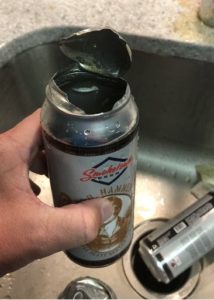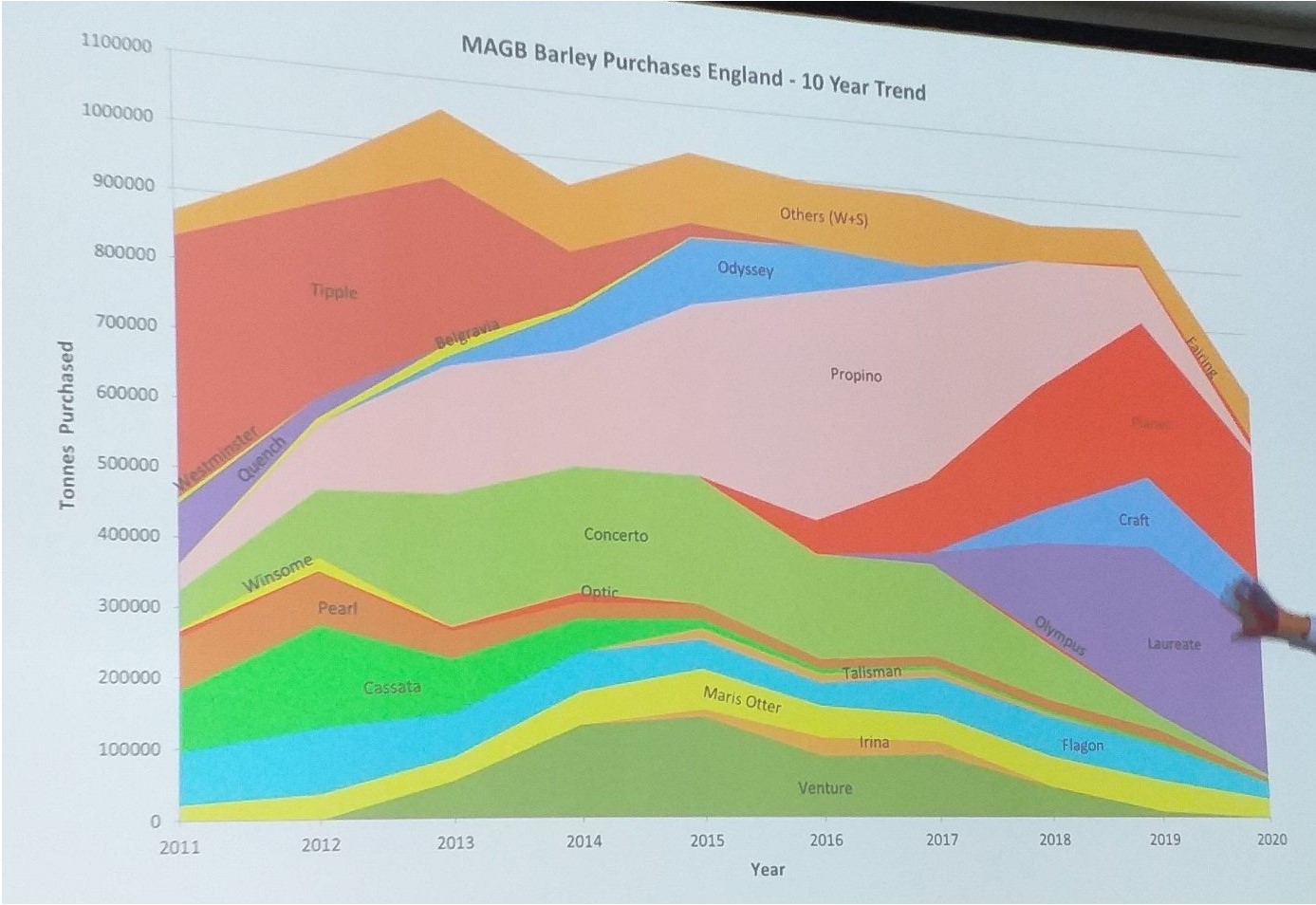Just two weeks and a bit to go. Remember how 2020 dragged on and on? 2021 seems like it was less than a month long. Got my third jab. Thanks for asking, the only side effect has been just a bit of a lingering cold. Are you Christmassy? Me, not like in 2015 when Boak and Bailey won the last Christmas Yuletide Hogmanay Kwanza Beery Photo Contest with the entry above. Why? Just nine days to go but we are having a big big wave* of da-‘Vid around here so joining last minute shopping crowds might not be wise. Good to substitute:
Look, kid – mustard is a perfectly good stocking stuffer. Stop crying… please… have a Brazil nut… no, that’s all there was left at the gas station… check at the bottom of that stocking… yup… handkerchiefs… what, again with the crying?
Ho ho… ho. First up, if you yourself in need a bit of a Christmas gift, The Lars himself is speaking on line next Tuesday at 3 pm Eastern (my time zone is the best!) as he is set to speak at the Chicago Brewseum’s latest event:
Yule, the multi day festival celebrated by pre-Christian Germanic peoples, begins every December 21st. The modern Christmas celebration is very different from the old celebration of Yule as Norwegian farmers knew it, yet at the heart of both sits the feast with the Christmas beer. On this Winter Solstice, Lars Marius Garshol joins us from Norway to take a long look back to the origins of the Christmas feast, and why beer was so central to it. At the center of the mystery we find not Santa Claus, but his forgotten cousin.
Also, just in time for the holiday joy, Dr. Wade at braciatrix reached back 400 years or so to the early 1600s offered some top advice on how to get through this challenging holiday season – butter beer!
Butter beer, or buttered beer, has a long and storied history. There are many recipes all containing at least the butter, sugar, beer and eggs, though the variety of spices seems to vary greatly with some including nutmeg, cloves and ginger, whilst others opt for aniseed and licorice.
That might be worth a try. My go to mulled ale is usually just Chimay Red in a pot warmed with a cinnamon stick. Speaking of fun, there was lots of follow up from last week’s post on the problem of style. I understand it is referred to in Finland as se in certain circles. And this week, we learned that there is another convoluted BJCP style update coming and I also read the words “spicy-guava Lithuanian-influenced Meadow Land IPA” written by Ruvani de Silva. I am inclined to consider that hard to the one end of the newly christened “style<->fun” continuum. Ron also contributed to the question when he questioned the relevance of the construct when considering Edwardian ales:
Whitbread’s Edwardian beers are bound to get a style Nazi in tizzy. Because they certainly don’t fit with the modern hierarchy of Pale Ales. With their IPA being significantly weaker than their Pale Ale. Whitbread IPA was a latecomer to the party, first brewed in October 1899. They’d been in the Pale Ale game since the 1860s and already brewed three different ones – PA, 2PA and FA, in descending order of strength. With IPA slotting in just above FA. So, what made this beer an IPA? The fact that the brewery called it that. I can’t work on any other basis. Were British breweries consistent in their use of the term IPA? Like hell they were. And particularly liable to use PA and IPA pretty much randomly. There’s no point searching for a pattern, because there isn’t one.
Noticing things as they were and are can get a bit sticky. The Tand himself captured this idea in a post yesterday about stout:
It isn’t that I’m against such stuff, and I agree and recognize that there are plenty out there that like these additions, but what I do dislike is that a bit too often, there isn’t just a straightforward stout that tastes of, well, stout. There are exceptions of course, and maybe too many brewers feel that a “normal” stout doesn’t get them sales in a crowded market. Well that’s fine, but let’s at least have an unmucked about version as the default, with the additions as specials.
Where does that sit on the “style<->fun” continuum? Interesting and perhaps somewhat related observations from Boak and Bailey on the role craft beer can play as harbinger of change in gentrification of neighbourhoods, whether those living there like it or not:
Bedminster is made up of multiple neighbourhoods, from the theatre and coffee shop gentrification of Southville to the betting shops and greasy spoon caffs of East Street. The pubs there tend to be either (a) busy and down-to-earth, with stern warnings to shoplifters in the windows; or (b) shut. The borders, though, have fuzzy edges and are porous and, as you might expect, the gentrification is leaking. There are now vegan delicatessens and houseplant emporiums alongside branches of Gregg’s and Poundland. Alpha occupies a retail unit in a 1980s red-brick shopping arcade, across from a kebab house and next door to a charity shop. It feels out of place, for now – but probably won’t in five years’ time.
Change is odd. You can spot it in liminal spaces. Or does it sometimes create the liminal space, the bit that gets abandoned to become a space between before it gets repurposed? Craft beer is probably a follower as often as not in these things even if it sounds like may receive undo attention compared to the fifth column of big houseplant in these matters. Fern pushers. No good comes of ferns.
Elsewhere… good news in another remote pub story from Britain!
A community on the Isle of Bute has raised more than £92,000 to put towards the purchase and refurbishment of their 200-year-old pub. The Anchor Tavern in Port Bannatyne was put up for sale after it was shut due to a downturn in business caused by the Covid-19 pandemic. It was the last pub in the village following the closures of other licenced premises.
Among the things I wrote these last few days that caused upset for some poorly enunciated reason or another** was the idea that best of lists sorta suck. While Robyn and Jordan make good case for properly run awards in this week’s podcast (while rejecting guava – are they really that fun?)… like the minor league golf tour of weekly sponsored events that beer awards have become (no doubt to give all those vitally important awarding people enough opportunity to prove their really important judging powers by awarding awards) I’ve long wondered whether there any other part of pop culture where the “best of” lists are filled with generally inaccessible items like we see with beer? Eric Asimov in the NYTs shared his best of 2021 wines and I was immediately struck by this first item in his list:
This bottle is a thirst quencher, an uncomplicated $19 liter of red from the Bío Bío region of Chile. So what’s memorable about it? For me, it epitomized how wine is evolving.
Modest price, an over-sized bottle and contextualized to make a greater point. Beer reviews rarely even mention price let alone distribution. We deserve better. Now consider NPR’s Sound Opinion‘s best albums of 2021. In their newsletter they asked “What We Mean By Best Albums”:
…let’s call our Sound Opinions best-of lists what they really are: idiosyncratic, no-two-exactly-alike rankings of personal favorites. We’re not looking for consensus, we’re aiming for let-it-all-hang out personality as reflected by the music each of us love the most. That’s why we devote an entire show to this imperfect exercise every year. It’s fun to reflect on the recordings that sustained or inspired us when we were running errands, washing dishes, hosting a party, recovering from a long work day or just getting lost between the headphones on the couch.
Self-deprecating, accurate and personal. An imperfect exercise. Look for these sorts of qualities in any recommendations before you fall in behind the fog offered otherwise.*** Look for price, actual personal comment and not just the PR notes – plus whether there was actually any sort of possibility anyone (aka you) beyond the sample receiving set was ever going to have a taste.
Very related, sometimes you read things that make you think “hmmm, interesting” and sometimes you read things that make you think “is anything in this actually true?” Oh dear. “Style”? Not in 1977. “Juicy”? More like 2007. Still, expect a NAGBW award for that one. For sure. Meets the club house requirements.
Conversely, speaking of context and reality, I heard a great show on one of CBC Radio’s schedule challenged broadcasts, Now or Never, Saturday aft. It was all about the relationship people have with alcohol. The episode has not popped up on the podcast page yet but keep an eye out for it. There’s a great interview with one Winnipeg craft brewer on the conflict of producing something that harms some while is fun for most. [Update: here it is!]
Want a bit more reality, I hope you are taking a moment to see the green dot in the sky these days. Not a lot of green dots in the sky. Green dot? Yup:
Your once-in-a-lifetime chance to see a green comet named C/2021 A1 — a.k.a. Leonard — is here. Astronomy experts, including the comet’s discoverer, offer tips on when and how to see the comet. Like other comets, Leonard is a ball of frozen gas, rocks and dust. When its orbit brings it close to the sun, the heat causes some of that material to vapourize, which makes it glow and sprout a tail of gas and dust.
Leonard? Hallelujah! Because when the world is a bit too grim and people are just too much face, why no climb way up to the top of the stairs where your cares might just drift right into space. Because you are gawking at a green dot. And you can take a drink up there with you. Something festive.
There. I tried to keep it short. Can you believe it? No? Well, the holidays are here. Be happy – and while you are being happy please also check out the updates from Boak and Bailey mostly every Saturday and from Stan every Monday, plus more with the weekly Beer Ladies Podcast, and at the weekly OCBG Podcast on Tuesday and sometimes on a Friday posts at The Fizz as well. There is a monthly sort of round up at The Glass. (Or is that dead now?) There is more from the DaftAboutCraft podcast, too. And the Beervana podcast. And sign up for Katie’s weekly newsletter, The Gulp, too. (That’s a bit now and then now.) And check out the Atlantic Canada Beer Blog‘s weekly roundup. Plus follow the venerable Full Pint podcast. And Fermentation Radio with Emma Inch. The AfroBeerChick podcast as well! And also look at Brewsround and Cabin Fever. And Ben has his own podcast, Beer and Badword (which he may revive some day…) And remember BeerEdge, too, and The Moon Under Water.
*Sadly, the recent events in Kingston around anti-vaxx also caught up a neighbouring craft brewery, Signal. The owner died of Covid-19 Wednesday. It might have triggered further outbreaks.
**Huh?
***Co-opting a crisis is one of the more distasteful things you can do so it was sad to see one of the worst examples of appropriating aggrandizement in a headline I read this week: “Kentucky Breweries Lead Relief Efforts Following Deadly Storms.” What they meant to say, as the story does, is some brewery owners are pitching in as they would and should but pretty sure the normal authorities and charities are leading relief efforts.











